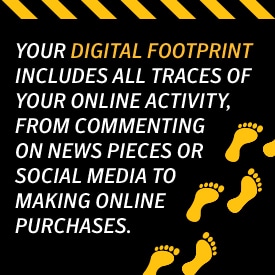How to clean up your online digital footprint
Your “digital footprint” includes all traces of your online activity, from commenting on news pieces or social media to making online purchases. When you know the boundaries of your digital footprint, and take steps to control it, you can protect your identity and your reputation.

Your “digital footprint” includes all traces of your online activity, from commenting on news pieces or social media to making online purchases. When you know the boundaries of your digital footprint, and take steps to control it, you can protect your identity and your reputation.
Digital footprints don’t merely attract the interest of hackers or those out to steal your identity. They can also be traced by potential employers, schools, or creditors. Managing your identity clearly matters.
Active Vs. Passive Footprints

One way to think about your digital footprints is to categorize them as either “active” or “passive.”
“Passive” footprints are those you leave behind without intending to do so or, in some cases, even knowing you are doing so. For instance, websites that collect information about how many times you have visited in the recent past are adding to your digital footprint in a “passive” fashion. You don’t choose to hand them this data; they collect it when a device at your IP address connects with their websites. Because this is a hidden process, you may not realize it is happening at all.
“Active” footprints, by contrast, are those you leave when you make deliberate choices on the Internet. Posts you make to your own social media channels are a well-known form of active footprint. When you are logged into a project management or similar site, changes you make that are connected to your login name are also part of your active footprint.
Both active and passive footprints can be tracked and observed in multiple ways and by multiple sources. When you take steps to control your digital footprint, you take steps not only to protect your own identity and reputation, but that of your family and friends as well.
Six Steps for Protecting Your Digital Footprint
Organizations like the Family Online Safety Institute recommend tracking your digital footprint and taking steps to control it. Recommended steps include:
1. Enter your name into several search engines.
Use multiple search engines to perform a search for your first and last name. If you’ve recently changed your name, look up both your prior name and your current one. Try the common misspellings as well. Review the first two pages of results. Are they positive? Do they show you in a professional and respectable light? If anything comes up that you don’t like, ask the site administrator to take it down.
2. Double-check your privacy settings, but don’t trust them.
Privacy settings on social media allow you to control who sees your posts on your social media streams. Spend some time getting to know these settings so you can use them fully – for example, Facebook allows you not only to limit posts merely to “friends,” but also to make customized lists of people who can see certain posts. However, don’t assume that privacy settings will protect you anywhere but on the social media site that uses them. For example, some Facebook users have reported finding their “friends-locked” photographs as public images on Google Image Search.
3. Create strong, memorable passwords.
Any time you need a password, create one that uses a combination of words, numbers, symbols, and upper- and lowercase letters. Make it a password that is easy for you to remember, but would be hard for someone else to guess. Avoid the most popular combinations, like birthdates, anniversaries, or the names of your spouse, children, or pets.
4. Keep all your software up to date.
Many viruses and malware programs are specifically designed to “mine” your digital footprint, and they are constantly being updated. To help protect yourself, make sure that your antivirus software and your other software programs are up to date. Older software is more vulnerable to attack.
5. Review your mobile use: if you don’t need it, delete it.
Set a password or lock pattern on your mobile device so that it cannot be accessed by other people if you accidentally lose or forget it. From time to time, review the apps on your phone or tablet. What are their privacy or information-sharing settings? If you don’t use an app anymore, delete it.
6. Build your reputation through your behavior.
Contribute to your positive, professional digital footprint by posting only those things that contribute to the image of you that you want your bosses, banks, or professors to see. Skip the negative tweets, “un-tag” yourself from questionable Facebook photos, and keep critical comments to yourself. Instead, build a positive reputation by starting a blog or website that showcases your work or a hobby about which you’re passionate.
Editorial note: Our articles provide educational information for you. Our offerings may not cover or protect against every type of crime, fraud, or threat we write about. Our goal is to increase awareness about Cyber Safety. Please review complete Terms during enrollment or setup. Remember that no one can prevent all identity theft or cybercrime, and that LifeLock does not monitor all transactions at all businesses. The Norton and LifeLock brands are part of Gen Digital Inc.





Want more?
Follow us for all the latest news, tips and updates.